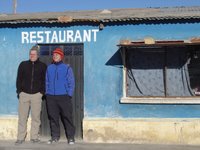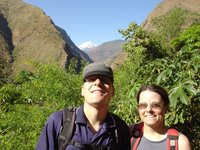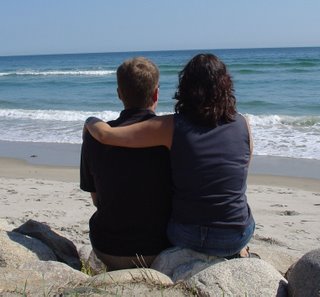Peru
 The first bus ride in Peru was the worst on our trip so far and this for 7 hours. We were glad that this chicken bus arrived in one piece and we a live in Arequipa. Next day Line and Patrice, friends from Montreal, Canada joined us. The next 3 weeks we were travelling through Peru together. First we visited to the former “luxury” Monastery de Santa Catalina, which is a paradise for photographers.
The first bus ride in Peru was the worst on our trip so far and this for 7 hours. We were glad that this chicken bus arrived in one piece and we a live in Arequipa. Next day Line and Patrice, friends from Montreal, Canada joined us. The next 3 weeks we were travelling through Peru together. First we visited to the former “luxury” Monastery de Santa Catalina, which is a paradise for photographers. 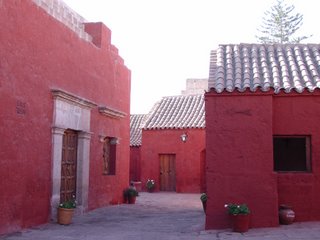 At the museum Santuarios Andinos we could get some information about „Juanita, the Ice Princess“ – the frozen Inca maiden sacrificed on the summit of Mt Ampato (6288m) over 500 years ago.
At the museum Santuarios Andinos we could get some information about „Juanita, the Ice Princess“ – the frozen Inca maiden sacrificed on the summit of Mt Ampato (6288m) over 500 years ago.
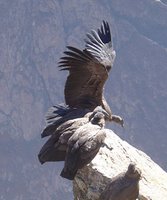
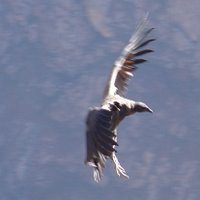 We joined a tour to the Colca Canyon, which is 3191 meter deep. Only its neighbour the Cotahuasi Canyon is 163 deeper and is the world’s deepest canyon. The highlight was definitely the viewpoint “Cruz del Condor”. We were lucky and could observe a large family (more than 20 birds) of Andean condors. Those huge birds (3 meter wing wide) were soaring just above our heads. It was a pleasure the watch them gliding in the canyon.
We joined a tour to the Colca Canyon, which is 3191 meter deep. Only its neighbour the Cotahuasi Canyon is 163 deeper and is the world’s deepest canyon. The highlight was definitely the viewpoint “Cruz del Condor”. We were lucky and could observe a large family (more than 20 birds) of Andean condors. Those huge birds (3 meter wing wide) were soaring just above our heads. It was a pleasure the watch them gliding in the canyon.  Our guide was excited as well, so that means, not every day there are so many condors around. We didn’t go for a hike in this canyon, because we assumed that Line and Patrice will suffer under altitude sickness. Unfortunately they had some problems, but luckily only on the first days. On half of the way back to Arequipa, we catched a bus in middle of nowhere. We were heading to Puno, which lies on the Lake Titicaca.
Our guide was excited as well, so that means, not every day there are so many condors around. We didn’t go for a hike in this canyon, because we assumed that Line and Patrice will suffer under altitude sickness. Unfortunately they had some problems, but luckily only on the first days. On half of the way back to Arequipa, we catched a bus in middle of nowhere. We were heading to Puno, which lies on the Lake Titicaca.
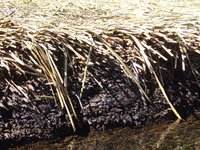 The small port of Puno is the best departure point for forays to Lake Titicaca’s various islands. We visited the unique Uros islands, (Floating Islands). The islands are built using many layers of the buoyant totora reeds that grow abundantly in the shallows of Lake Titicaca. The islands’ reeds are constantly replenished from the top as they rot away, so the ground is always soft and springy.
The small port of Puno is the best departure point for forays to Lake Titicaca’s various islands. We visited the unique Uros islands, (Floating Islands). The islands are built using many layers of the buoyant totora reeds that grow abundantly in the shallows of Lake Titicaca. The islands’ reeds are constantly replenished from the top as they rot away, so the ground is always soft and springy.By far the best way to see Lake Titicaca is by spending a few days visiting the culturally fascinating island of the lake itself. Therefore we decided to board a local boat and headed to the Taquile Island.
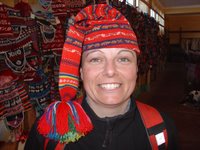 The only accommodations are home stay by locals. Beds are basic but clean. After the tour boats left, it was nice and quiet. Time to discover this small island. The locals have a deeply ingrained tradition of weaving. The men folk’s are wearing woollen heats, which they take great pride in knitting themselves.
The only accommodations are home stay by locals. Beds are basic but clean. After the tour boats left, it was nice and quiet. Time to discover this small island. The locals have a deeply ingrained tradition of weaving. The men folk’s are wearing woollen heats, which they take great pride in knitting themselves. Soon after the Islands we travelled to Cusco. The beautiful city of Cusco (population 350,000, elevation 3326 m) was once the foremost city of the Inca empire. Massive Inca-built walls line the city’s central streets and form the foundations of both colonial and modern buildings. When the Spaniards had conquest the Inca empire, they destroyed almost everything. However for disgrace in Cusco are still some foundations left.
Soon after the Islands we travelled to Cusco. The beautiful city of Cusco (population 350,000, elevation 3326 m) was once the foremost city of the Inca empire. Massive Inca-built walls line the city’s central streets and form the foundations of both colonial and modern buildings. When the Spaniards had conquest the Inca empire, they destroyed almost everything. However for disgrace in Cusco are still some foundations left.
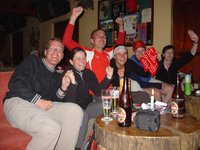 On 23. June 06, of course we couldn’t miss the Swiss soccer game against South Korea. Switzerland won and we and other Swiss took over the pub into the deep night. We only say that some beers were sold.
On 23. June 06, of course we couldn’t miss the Swiss soccer game against South Korea. Switzerland won and we and other Swiss took over the pub into the deep night. We only say that some beers were sold. Next day we took part of the Inti Raymi (Festival of The Sun). This is the most important festival in Cusco and attracts tourists all over the world. The festival take place at the Sacsayhuaman Inca ruins, which gives an impressive scenery. Around 100 artist where acting and dancing. Next day we visited these ruins again without thousands of other people around. The constructions of the Incas are very impressive.
Next day we took part of the Inti Raymi (Festival of The Sun). This is the most important festival in Cusco and attracts tourists all over the world. The festival take place at the Sacsayhuaman Inca ruins, which gives an impressive scenery. Around 100 artist where acting and dancing. Next day we visited these ruins again without thousands of other people around. The constructions of the Incas are very impressive.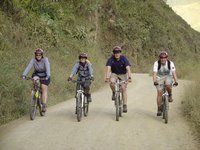 The 4 days INCA JUNGLE TRAIL TOUR from Cusco to Machu Picchu was worth its money. After a 7 hours bus ride in a “chicken bus” over the Abra Malaga Pass was exciting and also a little scary because of the steep cliffs. We where all happy when we could ride the bikes downhill by our self.
The 4 days INCA JUNGLE TRAIL TOUR from Cusco to Machu Picchu was worth its money. After a 7 hours bus ride in a “chicken bus” over the Abra Malaga Pass was exciting and also a little scary because of the steep cliffs. We where all happy when we could ride the bikes downhill by our self.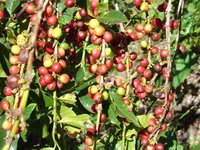 The road went through coffee and tee plantations which was fun. In all small villages people where so friendly and almost everybody shouted “HOLA”. We slept in Santa Maria, where we found out, that Switzerland lost their soccer game against Ukraine in penalty shootings. Bye, bye World Cup 2006.
The road went through coffee and tee plantations which was fun. In all small villages people where so friendly and almost everybody shouted “HOLA”. We slept in Santa Maria, where we found out, that Switzerland lost their soccer game against Ukraine in penalty shootings. Bye, bye World Cup 2006. We were the last group who started hiking next day, but soon we passed all other tour groups. We can not deny, that we are hillbillies J. First it was steep and exhausting but in a beautiful landscape with its coffee plantations in its high jungle. On the way we saw some Avocado, papaya trees and pineapple plants. The Inca path went further along steep cliffs. After lunch the path went along the river were we were crossing some shaky bridges. Our guide’s advise “walk in the middle, the wood is rotten” didn’t take away our worries. The crossing with the cable railway was fun though. After so many hours hiking we really enjoyed the bath in the very nice located hot springs between the mountains.
We were the last group who started hiking next day, but soon we passed all other tour groups. We can not deny, that we are hillbillies J. First it was steep and exhausting but in a beautiful landscape with its coffee plantations in its high jungle. On the way we saw some Avocado, papaya trees and pineapple plants. The Inca path went further along steep cliffs. After lunch the path went along the river were we were crossing some shaky bridges. Our guide’s advise “walk in the middle, the wood is rotten” didn’t take away our worries. The crossing with the cable railway was fun though. After so many hours hiking we really enjoyed the bath in the very nice located hot springs between the mountains. 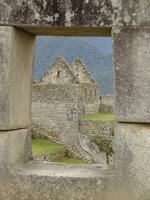 After 12 hours we were glad to arrive in Santa Teresa. However our accommodation was a little too basic and had a lot room for improvement. We just say “we all skipped showering”. The next day hike wasn’t as impressive as the day before but also nice. We hiked along a river and the railway track to Aquas Caliente. Again we where on the way for more than 8 hours and we looked forward for a deserved beer and a shower. At 5 o’clock next day we started our hike up to Machu Picchu. This spectacular and awe-inspiring location is the best-known and most spectacular archaeological site on the continent.
After 12 hours we were glad to arrive in Santa Teresa. However our accommodation was a little too basic and had a lot room for improvement. We just say “we all skipped showering”. The next day hike wasn’t as impressive as the day before but also nice. We hiked along a river and the railway track to Aquas Caliente. Again we where on the way for more than 8 hours and we looked forward for a deserved beer and a shower. At 5 o’clock next day we started our hike up to Machu Picchu. This spectacular and awe-inspiring location is the best-known and most spectacular archaeological site on the continent.  We learnt a lot from our guide about the Inca culture and Machu Picchu itself. About 70% is preserved and only 30% is reconstructed. In 1532 the Spaniards had not discovered this place, therefore it had not been destroyed. The Incas had chosen this location between the mountains because it lies at a strategic spot. Here starts the Amazons river and it is also the border to the jungle and the Andeans. 5 Inca trails are passing Machu Picchu, but unfortunately the tours are sold out for months and cost between 350 to 500 US-$. In our opinion it is way to much, remember we are still in Peru. (Tourist rip of)
We learnt a lot from our guide about the Inca culture and Machu Picchu itself. About 70% is preserved and only 30% is reconstructed. In 1532 the Spaniards had not discovered this place, therefore it had not been destroyed. The Incas had chosen this location between the mountains because it lies at a strategic spot. Here starts the Amazons river and it is also the border to the jungle and the Andeans. 5 Inca trails are passing Machu Picchu, but unfortunately the tours are sold out for months and cost between 350 to 500 US-$. In our opinion it is way to much, remember we are still in Peru. (Tourist rip of) With train and bus we commuted back to Cusco. Next day the 15 hours bus ride over the Andeans was not very pleasant and we were happy when we arrived in Nazca. (Americans: Just imagine driving Lombard Street, in SF, for 15 hours in a bus). Spread across an incredible 500 sq km of arid, rock-strewn plain, the mysterious Nazca Lines form a striking network consisting of over 800 lines, 300 figures, and some 70 animal and plant drawings are found in Nazca. There are for example a spider, a spaceman, a monkey, a condor, which can be more than a few hundred meters wide. The best ways to see these lines is a flight with a light aircrafts over the lines, which was very impressive. (http://de.wikipedia.org/wiki/Nasca_Linien)
With train and bus we commuted back to Cusco. Next day the 15 hours bus ride over the Andeans was not very pleasant and we were happy when we arrived in Nazca. (Americans: Just imagine driving Lombard Street, in SF, for 15 hours in a bus). Spread across an incredible 500 sq km of arid, rock-strewn plain, the mysterious Nazca Lines form a striking network consisting of over 800 lines, 300 figures, and some 70 animal and plant drawings are found in Nazca. There are for example a spider, a spaceman, a monkey, a condor, which can be more than a few hundred meters wide. The best ways to see these lines is a flight with a light aircrafts over the lines, which was very impressive. (http://de.wikipedia.org/wiki/Nasca_Linien) In Huacachina a tiny resort is dominated by giant sand dunes and nestles next to a picturesque lagoon. The right place to relax at the pool.
In Huacachina a tiny resort is dominated by giant sand dunes and nestles next to a picturesque lagoon. The right place to relax at the pool. In Pisco we joined a tour to the Ballestas Island. Guano producing birds include the bobby, pelican, Humboldt penguins and sea lions are found there. Impressive was to see so many birds on one place.
In Pisco we joined a tour to the Ballestas Island. Guano producing birds include the bobby, pelican, Humboldt penguins and sea lions are found there. Impressive was to see so many birds on one place. In Lima is not a nice city and also not very save for tourists, therefore we only spend a night in the nicer neighbourhood Miraflores. There have to sad goodbye to Line and Patrice. We enjoyed traveling with them. They went back to Canada and we flew to Washington DC. Back to the states, where we are going to pick up our car in order to cross the states and drive up to Alaska. Crazy?? Maybe! :-)
In Lima is not a nice city and also not very save for tourists, therefore we only spend a night in the nicer neighbourhood Miraflores. There have to sad goodbye to Line and Patrice. We enjoyed traveling with them. They went back to Canada and we flew to Washington DC. Back to the states, where we are going to pick up our car in order to cross the states and drive up to Alaska. Crazy?? Maybe! :-)
